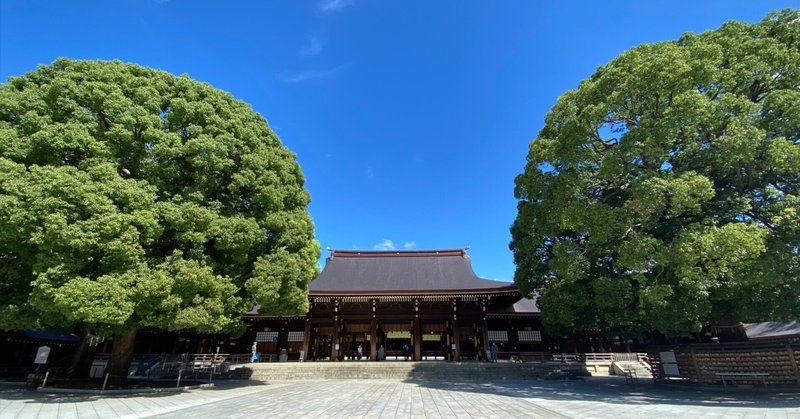
Meiji Jingu to Yoyogi Station. Walking route.
There are three ways to enter Meiji Jingu Shrine.
(1) Main entrance (Harajuku entrance)
(2) Yoyogi Entrance
(3) Sangubashi Entrance
Each of these entrances is located near the following stations.
(1) Main entrance (Harajuku Exit)
→Harajuku Station
(2) Yoyogi Entrance
→Yoyogi Station
→Kitasando Station
(3) Sangubashi Entrance
→Sangubashi Station
Sangubashi Entrance→Sangubashi Station
The recommended entrance is the main entrance
It takes about 1 km to the main shrine, but it is recommended to proceed to the main shrine while enjoying the nature in Tokyo.
2、Yoyogi entrance and Sangubashi entrance are about 500m to the main shrine.
*I personally prefer the Yoyogi entrance because of its straight approach from the torii gate.
https://www.meijijingu.or.jp/en/
Background of Meiji Shrine's Construction
Meiji Shrine was built to enshrine Emperor Meiji and Empress Shoken. Emperor Meiji, who spearheaded the Meiji Restoration, transforming Japan into a modern nation, along with Empress Shoken, significantly influenced many pivotal changes and developments in Japan. The shrine serves to perpetuate their achievements and spirits and provides a place where the nation can pay respect to them.
Path to Construction
Emperor Meiji’s Passing: After Emperor Meiji passed away in 1912, movements to construct something in his memory started among the citizens.
Proposal of Construction: Shortly after the Emperor’s death, the idea of constructing a shrine to enshrine him was proposed, leading to the creation of Meiji Shrine.
Site Selection: A site in Yoyogi, Shibuya, Tokyo was chosen for the shrine. This place was frequented by Emperor Meiji and Empress Shoken, where they spent many cherished moments.
Construction of Meiji Shrine
Initiation of Construction: The construction began in 1915. The project was perceived as a national endeavor, and funds were donated from many people.
Completion and Dedication: Meiji Shrine was completed and unveiled in 1920. Numerous citizens visited to express their respect to Emperor Meiji and Empress Shoken.
War and Reconstruction: Regrettably, Meiji Shrine was damaged in air raids in 1945 during World War II. Post-war, the shrine was reconstructed with support and donations from many citizens and completed in 1958.
Role of Meiji Shrine
While enshrining Emperor Meiji and Empress Shoken, Meiji Shrine communicates their ideals of enriching the nation and their internationalist spirit to the present day and transfers their teachings to the next generation. The forest of the shrine also stands as an urban oasis, serving as a place that values connections with nature. Various ceremonies, festivals, and cultural events are held, and many visitors from Japan and abroad experience its history and culture.
Basic information about Shinto and shrines
1. Shinto
Shinto is an indigenous belief system of Japan that worships nature, ancestors, and various deities. In Shinto, natural phenomena, animals, and even illustrious historical figures can be regarded as gods.
Key Features:
Polytheism: Shinto is a polytheistic faith, worshiping countless gods (kami).
Presence of Kami: It is believed that kami resides in all things.
Purity: Purity and cleanliness are emphasized in Shinto.
2. Shrine (Jinja)
Shrines are places that embody the Shinto faith and serve as sacred areas where deities are enshrined.
Main Elements:
Torii Gate: The gate at the entrance of a shrine. Passing through it symbolizes entering a sacred realm.
Haiden: The worship hall where visitors offer prayers to the kami.
Honden: The main hall where the kami are enshrined, usually not visible to the general public.
Important Concepts:
Festivals: Shrines host various festivals and events according to the season.
Visiting: Visitors clap their hands, offer money, and say prayers.
Amulets: Shrines sell amulets or charms believed to carry divine power.
3. Shinto Practice
Rituals: Festivals and ceremonies expressing gratitude to kami.
Everyday Shinto: Involves appreciating beautiful nature and showing gratitude towards the kami.
Shinto and shrines are deeply rooted in Japanese culture and tradition, and many people practice these beliefs and customs in everyday life and on special occasions.
Architecture and Environment
Torii (Gate)
Significance: The Torii gate serves to delineate the boundary between the sacred and the profane. Passing through it signifies entering a divine space.
Features: Meiji Shrine’s grand Torii gate, particularly large and made of wood, stands out distinctly. Each Torii gate has unique attributes in terms of material, shape, and color.
Main Hall (Honden)
Significance: The Main Hall is the most sacred place where the deities are enshrined and is typically not visible to general visitors.
Features: The Main Hall of Meiji Shrine prominently showcases traditional Japanese architectural style, with a design that is both simple and solemn. While the interior is not public, there are occasions during certain festivals and rituals where the hall can be glimpsed.
Worship Hall (Haiden)
Significance: This area allows the general public to offer their prayers to the deities. Sacred ceremonies also take place here.
Features: Meiji Shrine’s Worship Hall is designed to allow free access to general visitors, centered around a large plaza. The roof employs the traditional Japanese architectural style, known as irimoya-zukuri.
Kagura Hall (Kaguraden)
Significance: Kagura Hall hosts various ceremonies and events, such as festivals and weddings.
Features: While incorporating traditional architectural styles, it is utilized as an open space. Various traditional performances and rituals unfold here.
Gardens and Forest of Meiji Shrine
Despite being located in central Tokyo, Meiji Shrine is surrounded by expansive forests. The lush nature provides tranquility and peace to its visitors.
There is also a beautiful garden within Meiji Shrine, where visitors can enjoy the seasonal sceneries.
The structures at Meiji Shrine not only embody forms and functions but also reflect Japanese history and culture vividly through the choice of materials and construction techniques.
https://blog.with2.net/link/?id=2108693
この記事が気に入ったらサポートをしてみませんか?
